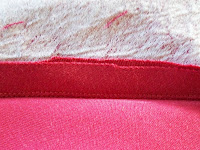Why has it taken so long? Partly having trouble finding enough energy to sew as my fibromyalgia has flared on and off, but also I discovered part way in that the fabric I'd chosen was a right pain to work with. I was obviously so seduced by the colour and print that I failed to notice just it was completely unnatural.
 I discovered the synthetic nature of the fabric when I managed to accidentally melt some of it while pressing a facing. Fortunately, it was the facing that melted, not the bodice itself. It did however lead to the death of my iron after attempts to clean the melted mess from the iron plate managed to get water or something inside and fritz the electrics. Aside from it's tendency to melt, the "right" side of the fabric had a slightly raised print which the iron would constantly catch on. In short, the fabric turned an otherwise simple project into a complete palaver.
I discovered the synthetic nature of the fabric when I managed to accidentally melt some of it while pressing a facing. Fortunately, it was the facing that melted, not the bodice itself. It did however lead to the death of my iron after attempts to clean the melted mess from the iron plate managed to get water or something inside and fritz the electrics. Aside from it's tendency to melt, the "right" side of the fabric had a slightly raised print which the iron would constantly catch on. In short, the fabric turned an otherwise simple project into a complete palaver.Fabric palaver aside, the dress is actually quite straightforward and easy to sew. I had no problems following the directions. I did french seams on the skirt, including the pockets. I under stitched my facings. The pattern needed a far amount of adjusting for my figure. As usual, I had to take a good inch off the bodice length. I also found that I needed to make the back narrower and adjust for my small, sloping shoulders.
Here's how the bodice pattern pieces ended up changing with my final pattern overlaying the original pattern.
The end result is fits and looks okay. But just okay. I have to say honestly that I don't love this dress. I may still be scarred from dealing with the nightmare fabric, but I also think this isn't the best style for me. The cross over at the back was difficult to fit and still manages to gape when I move, which then makes it slip off my small shoulders. I think it could use some decoration to emphasise the neckline. I had elected not to do the waist ties in contrasting fabric as I find a contrasting band can often cut me in the wrong place and emphasise my very short-waist. I'm happy with what I've made, but I think this may be joining a number of other dresses in my wardrobe that just don't feel quite right.
At least my dog Princess was still happy to be seen (and photographed) with me. As often happens, the one photo that is in focus, is the one where I'm pulling a face or in this case, have my eyes closed. Look at the dress and the cute puppy, ignore the rest :)
Right, next!


































